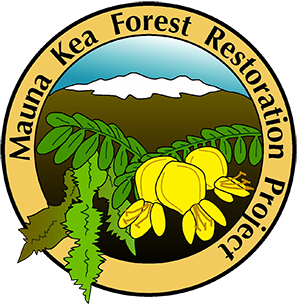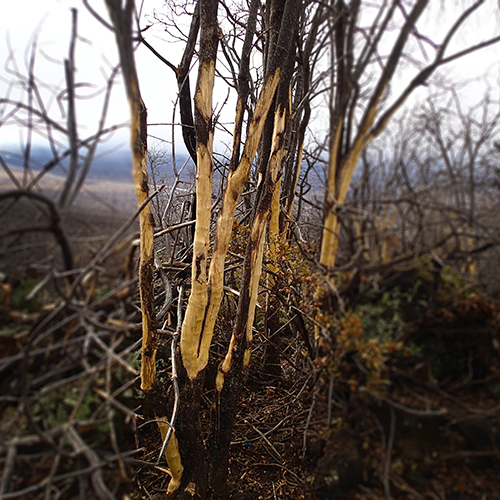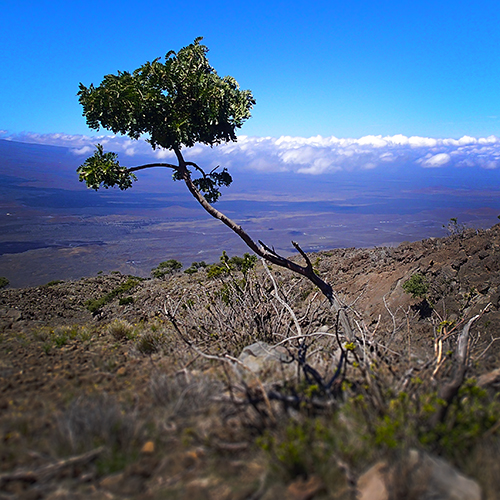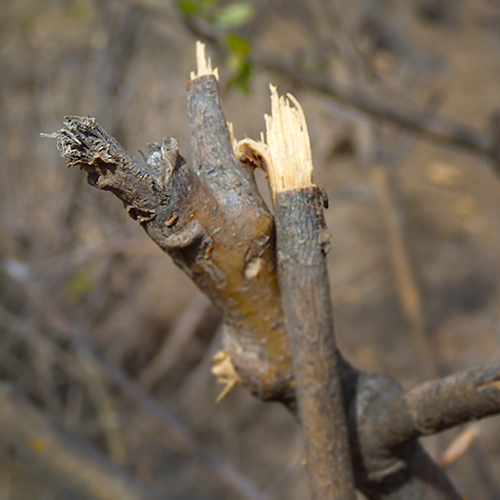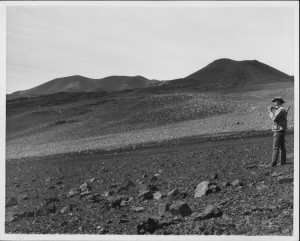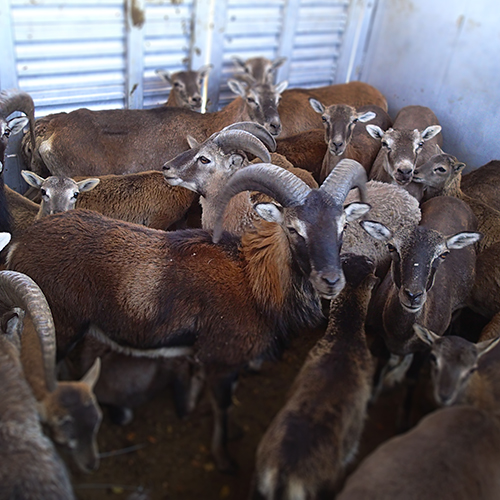THREATS
Mauna Kea’s high-elevation dry forest and the palila that live here are under constant threat from introduced animals, plants, insects, diseases, drought, and fire.
|
Sheep and GoatsNon-native browsing animals (1700s–1950):In 1935, Territory foresters rounded up over 50,000 feral sheep from Mauna Kea as seen here at Pu‘u Nanaha.
Sheep, goats, and cattle were introduced to the Island of Hawai‘i in the late-1700s by European explorers. Before this there were no grazing or browsing mammals anywhere in the islands. By 1825, feral cattle and sheep were found near the summit of Mauna Kea during the first recorded ascent by a westerner, botanist James Macrae. This period marks the beginning of large-scale destruction to the high-elevation dry forest by introduced browsing animals as their populations grew and they heavily browsed upon the nutrient rich māmane seedlings and trees. The leaves, limbs, and bark of māmane trees have no chemical (such as poison) or physical (such as thorns) defenses. Young seedlings and saplings are not tolerant to intensive browsing and may die as a result. The quotes below describe the damage to the māmane forests on Mauna Kea from browsing sheep that occurred for over 150 years. Fortunately, territorial foresters began addressing the problem by building a fence around Mauna Kea in 1937 and removing nearly 50,000 feral sheep, goats and cattle from Mauna Kea during the 1930s and 1940s.
“If the sheep are allowed to stay for long, as they presently do, all the grass and forest of the place shall be consumed. It will be an evil thing, for these sheep have exceedingly poisonous teeth.” —1856 letter from Isaac Y. Davis to Keoni Ana, Minister of the Interior, describing the impacts of feral sheep at the time.
“In some sections [sheep] have prevented any natural reproduction for many years past, and if this state of affairs was allowed to continue it would only be a matter of time before our mountains would be without a protective covering.” —Associate Forester L.W. Bryan, 1947, Twenty-five years of forestry work on the Island of Hawai‘i.
During drought periods, hungry sheep damage māmane saplings by stripping the bark and eating it. Māmane are browsed as far as the sheep can reach, creating an open understory with less food and protective shelter for native birds. The tips of māmane branches are often browsed, stunting trees and limiting their ability to survive especially during drought periods.
Non-native browsing animals (1950 to Present):Watch this video to see the effects of sheep browsing.
In the years following World War II, a combination of increased leisure time and improved access brought local game hunters to the mountain. By 1950, the Territorial Government switched management emphasis from eradication to management for sustained sport hunting. Sheep hunting seasons were declared closed from 1950 to 1955 to allow the population to increase In 1957, mouflon sheep were introduced to Hawai‘i Island. Shortly afterwards, biologists from the State Division of Fish and Game began crossbreeding purebred mouflon rams with feral ewes at Pu‘u La‘au on Mauna Kea. The hybrid and purebred mouflon sheep were all released throughout Mauna Kea from 1962–1966. Most, if not all of the sheep currently on Mauna Kea are hybrid-mouflon sheep. This 1963 photo shows a hunter looking for sheep on Mauna Kea .
In three rulings (in years 1979, 1987 and 1998), a federal judge ordered the Hawai‘i Department of Land and Natural Resources to stop maintaining any populations of feral sheep, goats and hybrid-mouflon sheep within palila critical habitat on Mauna Kea, and to completely and permanently remove feral sheep, goats and hybrid-mouflon sheep from critical habitat. During this period, DOFAW altered management in attempt to eradicate sheep from Mauna Kea. Hunting seasons for sheep and goats were opened year around and bag limits were removed. DOFAW also began conducting aerial shoots to remove sheep from palila critical habitat. Even with the management changes and years of effort attempting to remove sheep from Mauna Kea, many hybrid-mouflon sheep were still present in palila critical habitat in 2013. Over 3,000 sheep have been removed from Mauna Kea in 2013 by aerial shooting, aerial driving, and public hunting. Habitat degradation by introduced ungulates has been the most important factor driving the palila’s historical range contraction and population decline.
Hybrid-mouflon sheep were transported to new hunting grounds in the summer of 2013.
|
